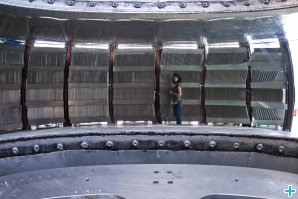Time-of-Flight spectroscopy
Overview
The Time-of-flight (TOF) technique is a general method for determining the kinetic energy of a traveling neutron, by measuring the time it takes him to fly between two fixed points whose distance is known.
It is particularly useful in the case of the neutron spectroscopy, where the energy of the scattered neutrons has to be determined.
Furthermore, the TOF technique can also be used for fixing the energy of the neutron beam before the interaction with the sample, i.e. for filtering a particular velocity, by means of a complex system of rotating disc choppers. This kind of chopper system is generally called monochromator, as it selects just a wavelength out of the incoming white beam. This analogy with the light spectroscopy is based on the wave-particle duality: neutrons with different kinetic energies are assigned different wavelengths according to the de Broglie's relationship: λ = h/mv (where h is the Planck constant, m is the neutron mass and v its velocity).
Thus, considering a beam of neutrons created at the same time and traveling in the same direction, the higher their kinetic energy the shorter their wavelength (and conversely for lower kinetic energy).
TOF spectrometers may be divided into two classes:
- Direct geometry spectrometers: in which the incident energy is defined before the sample by a device such as a monocrystal (Bragg diffraction principle) or a chopper system (TOF method), and the final energy is determined by time-of-flight between the sample and the detectors.
- Indirect (inverted) geometry spectrometers: in which the sample is illuminated by a white incident beam, the incident energy is determined at the sample position by the measurement of the time-of-flight, and the final energy is measured by a monocrystal.
At a pulsed source like a neutron spallation source, the natural operational mode for a spectrometer makes use of the TOF technique.
Where to find this technique?
Instrument animation
IN5, at ILL, is a typical direct geometry neutron Time-of-flight (ToF) spectrometer. This Flash animation shows how measurements are performed.

